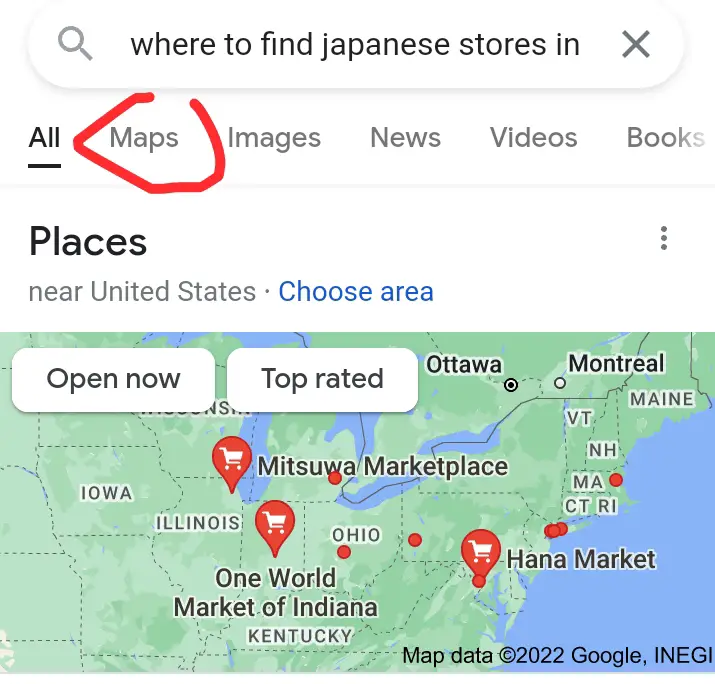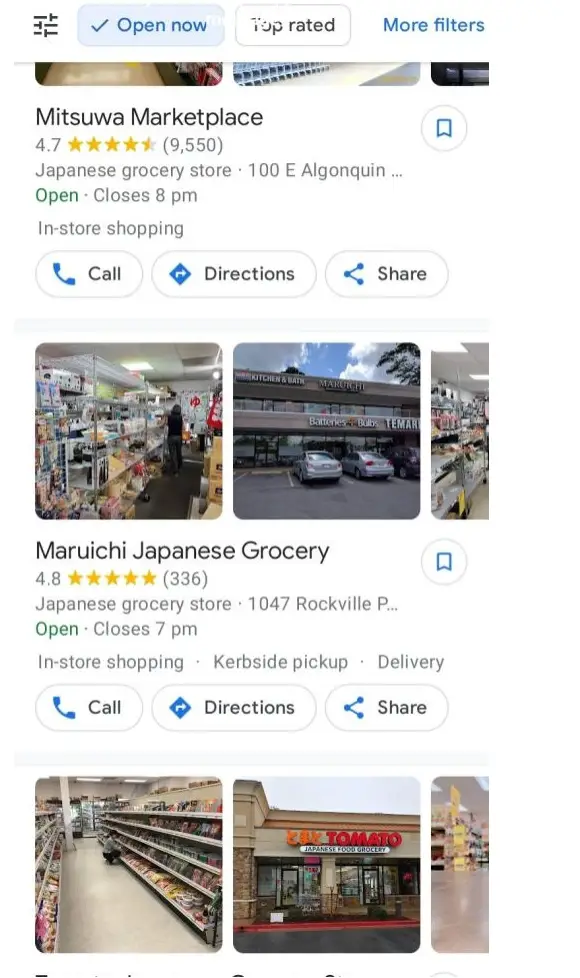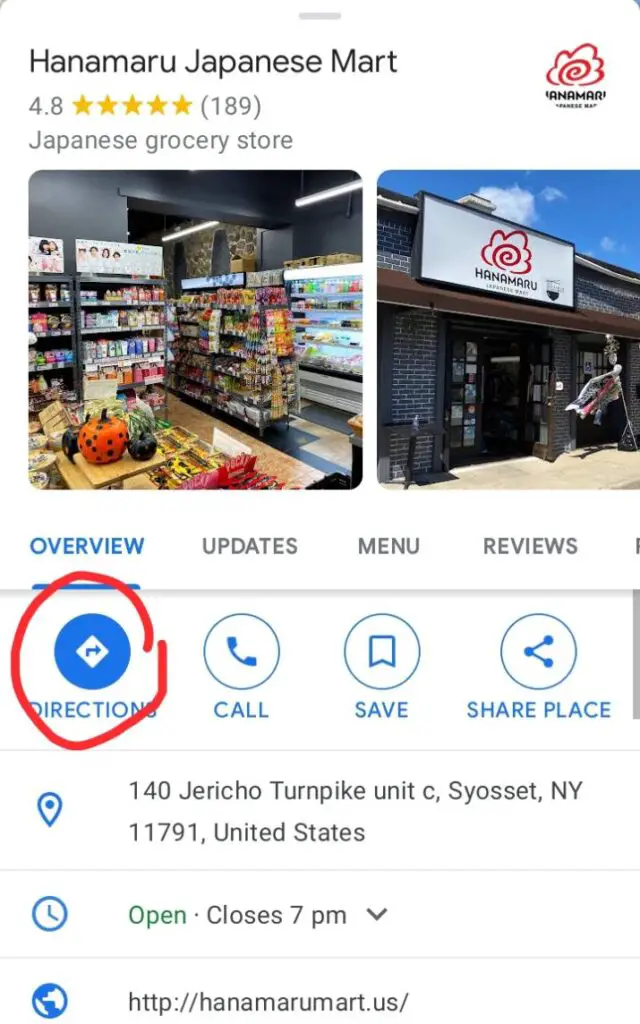You are probably Japanese or just someone who wants to have a taste of Japanese culture. Worry no more, because we have got you covered. In this article, I will be guiding you on how to find the closest Japanese store to you. Japan has a rich culture and most of the Japanese-themed stores share that same heritage. You might just be surprised that they are closer to you than you could ever imagine. Follow the instructions below on how to locate them.
- The first thing you must do is to turn on device’s location.
- Next, input in the Google search bar, “Where to find Japanese grocery stores around me”

- Then you click on “Maps” and you will be redirected to Google maps.
- A list of stores will come up. Click on “Open now” to filter the results

- You then make a pick
- From the one you chose, you can find out if it is open and then click on directions to get the closest route to the place.

Is Mitsuwa Japanese or Korean?
The Japanese-American chain Mitsuwa Marketplace sells groceries and has stores in a variety of states, including the Golden State, the Midwest, and the Pacific Northwest. If you’re looking for Japanese groceries in the United States, look no further than Mitsuwa Marketplace. Their shop stocks a comprehensive selection of Japanese food, household goods, electronics, and beauty aids.
The first Yaohan USA supermarket, a division of Yaohan, debuted in 1979 in Fresno. Yaohan ran eight locations across the United States at its height, in addition to four Daikichi sushi restaurants.
In the wake of Yaohan’s bankruptcy in 1997, regional management took over the American subsidiary and renamed it Mitsuwa Marketplace.
Mitsuwa kept opening new stores, primarily in the state of California. Kamei Corporation, a retail giant, purchased Mitsuwa in December of 2012.
How many Mitsuwa are in the USA? Mitsuwa runs eleven supermarkets across the United States.
Is there a little Japan in the USA?
The massive influx of Meiji-era Japanese to the United States prompted the development of Japantowns (1868–1922). Many poor Japanese at the time hoped to improve their lot by moving to the United States. Many early Japanese settlers went to the Western United States and Canada.
There were as many as 43 separate Japantowns across the state of California at one point, from the several square blocks that make up Little Tokyo in L.A. to a farming community like Marysville. Japanese language tutorial centers for the children of immigrants, Japanese newspapers, Buddhist churches, and even Japanese hospitals were commonplace in these areas. Due to the incarceration of Japanese people during World War II, many of these neighborhoods either shrank drastically or vanished entirely.
Commercialization, reconstruction, gentrification, and a declining Japanese population are just some of the challenges facing the three remaining Japantowns in the United States.
Los Angeles, San Francisco, and San Jose in California are home to the only three Japantowns of any importance in the United States.
San Francisco
San Francisco’s Japantown contains only six blocks, but it serves as a vital center for the city’s 12,000 people of Japanese ancestry. After the 1906 earthquake in San Francisco, which leveled much of the historic Japantown on southern Market Street, the area began attracting Japanese people. The Japan Center, a five-acre shopping and dining complex, is the economic nerve center of Japantown. A cinema, motels, Japanese spas, and sushi bars can all be found there.
Los Angeles
Los Angeles’ Japantowns is home to a large number of Japanese residents. Its location is close to the city’s business hub. The substantial Japanese-American population in Southern California has a focal point in this city, which is home to a civic center, a production house, the joint National Museum, and a variety of shops and eateries.
Little Tokyo as the L.A Japantowns is called, is situated in the center of downtown Los Angeles, and has one of he largest populations of Japanese American outside Japan. There are only three recognized Japantowns in the US, and they are all located in the state of California.
Dating back to the turn of the twentieth century, this neighborhood (also known as “Little Tokyo”) serves as Southern California’s epicenter for the Japanese American community. In 1995, the area was designated as a National Historic Landmark District .
San Jose
In the early 20th century, many Japanese people moved to the area surrounding Taylor and Jackson streets, close to Chinatown. Most of the town’s inhabitants were bachelor males who made their living picking fruit and vegetables.
U.S. servicemen’s Japanese wives and children were granted permission to leave the country as part of the Gentleman’s Agreement between the two countries in 1907. This increased the population of Japanese Americans and resulted in the establishment of a Buddhist temple, a school, and a United Methodist Church in Japantown.
Unlike many other Japantowns, this one thrived after the Second World War and is now home to a variety of businesses. Produce, baked products, and flowers can all be found at the nearby farmer’s market.
Where is the biggest Japantown?
Japantown in San Francisco has served as the regional hub for the Bay Area’s Japanese-American communities since its founding in 1906. Of the three remaining Japantowns in the US, it happens to be the biggest and most populous.
Both Little Tokyo and San Jose’s Nihonmachi can be found in the Golden State of California. You can taste the real Japanese culture here, having a try at their various stores and kitchens. Everything can all be found there, making it a fascinating site to visit even today.
Stopping by Japantown is a bit like taking a day trip to Osaka, where you may experience traditional and modern Japanese culture. San Francisco’s Japantown might be overshadowed by the city’s more well-known Chinatown, but it still packs a surprising number of attractions into a relatively small space.
San Francisco’s Japantown is a business district that consists of six blocks of restaurants and stores on Sutter Avenue. The Japan Center shopping mall and the nearby Buchanan Street pedestrian mall both include a large number of stores. Before the Second World War, this was the main hub of the Japanese community in San Francisco.
Shopping for souvenirs and charming, anime-inspired items is a great way to have a wonderful time, but there are a lot more activities to do in Japantown, such as visiting temples and shrines, eating at various ramen restaurants, and visiting their theaters.
At what time does Japantown close?
Shops in the vicinity typically close between the hours of 6:00 and 7:00. A few, though, may go on past 8:00 p.m. In Japan, restaurants often close at 10:00 pm or when the last customer departs. Some of them stay open as late as 11 p.m. on the weekends. Nonetheless, it is quite unusual to observe any that go past midnight.
Exactly where in Los Angeles is Japantown?
Los Angeles’ Japantown, known as Little Tokyo, is a cultural hub for Japanese-Americans and a meeting place where people of all backgrounds may experience a taste of Japan. You may find it in the heart of Los Angeles’s bustling downtown area. Approximately six city blocks make up this area. It is bounded to the west by Los Angeles Street. It is bordered by Alameda Street on the east, First Street on the north, and Third Street on the south.
Many museums and libraries can be found in Little Tokyo, making it a popular destination for tourists. If you’re craving some Japanese food, they also have plenty of restaurants and pubs to choose from. This Japantown is an important component of LA’s historical and cultural fabric.
Is Little Tokyo walkable?
Among LA’s many walking areas, Little Tokyo is a prime example. Spanning three city blocks from east to west, from Alameda to Third, and from Third to Los Angeles, the area is bounded by these streets. A former sailor established a restaurant in 1885, making Little Tokyo one of the city’s oldest communities.
Is Little Tokyo open on Sundays?
Little Tokyo’s shops and boutiques are open seven days a week. But this is still subject to the discretion of the business owners. The closing times for various businesses are still dependent on this. Some might decide not to open on Sundays, while some might decide to open but for a shorter length of time.
